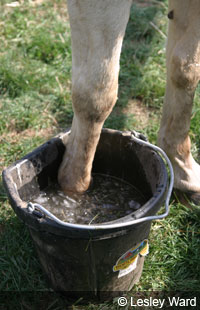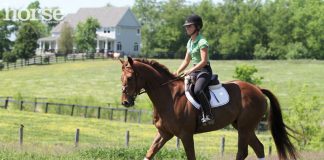If you suspect that laminitis (or founder, as it is known in layman’s terms) is to blame for your horse’s sudden lameness, call your veterinarian immediately. Then, follow this first-aid protocol while waiting for the vet’s arrival. As you administer the first aid, note your findings so you can report them to your vet:
2. Has your horse had a recent diet change, or has he indulged in something that’s normally off-limits or carefully rationed, such as grain or other sweet feed? Too many carbohydrates (sugars) at one sitting are a trigger factor in some laminitis cases. Another factor: pasture grass. Spring and fall pastures contain higher levels of fructans (sugars), and are the culprits in many laminitis cases.
3. Pay attention to your horse’s demeanor. Does he seem worried? Look at his stance. Is he trying to shift weight off of both front feet, or maybe a particular limb? If so, he’s in pain.
4. Look at your horse’s hooves. Are there any defects—any wounds or draining tracts around the heels or coronary bands? Draining tracts can indicate an abscess, and an abscess often goes hand-in-hand with laminitis. Are his hooves worn down extensively? A barefoot horse worked on hard surfaces over a long period of time can suffer dangerous wear and tear that predisposes him to “road founder” (another layman’s term for laminitis).
5. Check for heat and increased digital pulse along all four hooves. To check for heat, palpate each hoof. Does one seem warmer to the touch than the others? To check for an increased digital pulse, feel behind each fetlock. A bounding digital pulse can indicate inflammation and pain associated with laminitis. Keep in mind that laminitis can strike one hoof, or more! Most often, laminitis affects the front feet.
6. Trotting a horse out is a way to evaluate soundness, but if you suspect laminitis wait for your veterinarian to arrive first. Trotting a lame horse—particularly one suffering laminitis–for an extended period can cause further damage. If your horse is suffering a bout of laminitis, he will probably be reluctant to move, but just in case, keep him in a stall or small paddock while waiting for the vet’s arrival.
7. Immerse the affected hoof or lower limb in a tub of ice and water (from just below the knee and down) until your vet arrives. This step in the laminitis first-aid protocol is critical: The cold therapy brings down inflammation inside the hoof and helps slow further damage. For many horses, this step can make the difference in recovery.
8. Don’t medicate your horse unless your vet advises. If your vet is expected to arrive soon, withhold all feed, particularly feed high in sugar (sweet feed, spring or fall pasture grass, et cetera).
Laminitis is a life-threatening disease, and sometimes even the best care doesn’t change an unfortunate outcome. However, with prompt veterinary attention and proper first aid, your horse’s chances at a successful recovery increase immensely.
More on laminitis >>






I think we should all be reading this-just in case. This is especially true after Barbaro and his high profile case of laminitis. That really increased awareness in the horse community! Be prepared-it’s always better that way!
This list will come in handy thank you
great advise !
I’m glad I found this article. I just moved my horses and was a little concerned about them on pasture too long. It looks mostly weeds, clover & such but is pretty dry. Now I know what to look for.
My 5 year old quarter horse managed nightly raids to a cattail spring….could the cattails have contributed to her laminitis signs?
Thanks for your service to the equine community!
good tips!
I am reading this article just in time, the rescue pony I have looks like she is foundering again. I follow most of these tips, already. I have a great farrier.
I is hard to soak my horses foot, so I made a mud hole for her feet, where she likes to stand.
We caught it early with my horse. I pulled the front shoes on my horse, and my Vet gave him the best barefoot break over/roll with a file. He then packed each hoof with Tighten-Up, padded both with folded over-very thick cotton , and wrapped it up with strong Duck-tape. I repeated this again in 2-days. I immediately put my horse in a FLAT, good grounded, 200ft long//50 ft wide paddock with shelter. I exercised/walked him every day, and changed his diet. I also continue to give him “Best Health Hoof pellets”, from Costco online-(only). He is doing wonderful, this really worked for my horse.
I wish I knew the back history of the rescue pony I have. She seems like her feet are bothering her, but the farrier does not think she founder, but I am taking the above tips and advise.
Good article and advise. Easy to understand and follow.
Very good article.